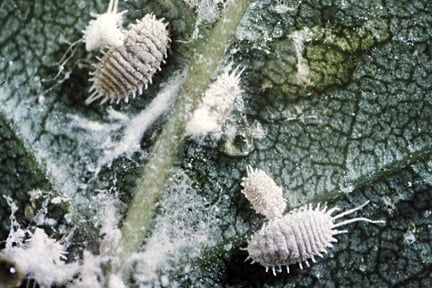
Quick facts
Common name - Mealybug
Scientific names - Planococcus citri, Pseudococcus longispinus, P. calceolariae and others
Plants affected - Many houseplants and greenhouse plants
Main symptoms - Fluffy white wax, honeydew and sooty moulds
Most active - Year round
What are glasshouse mealybugs?
Typically covered in a white waxy material, mealybugs are sucking true bugs (Hemiptera) closely related to scale insects and often considered to be unarmored scale insects. Most species are found in moist warm climates and those that occur in the UK are typically found in glasshouses and other protected environments.
Glasshouse mealybugs are common insects that tend to live together in clusters in inaccessible parts of plants, such as leaf axils, leaf sheaths, between twining stems and under loose . There are also some mealybug species found on plant roots. Mealybugs suck sap from plants and then excrete the excess sugars as a substance called honeydew. This lands on the leaves and stems were it is often colonised by , giving the surfaces a blackened appearance.
- Glasshouse mealybugs are found mainly on greenhouse plants and houseplants, especially cacti and , African violets, bougainvillea, citrus plants, fuchsia, grape vines, hoya, orchids (especially Phalaenopsis), oleander, passion flower, peach and tomato
- Some other mealybug species can attack outdoor plants, such as ceanothus, laburnum, New Zealand flax (Phormium mealybug) and redcurrant
- Glasshouse mealybugs thrive in warm conditions and are rarely found on outdoor plants. Glasshouse mealybugs are active all year round on houseplants and in greenhouses
- Some species of glasshouse mealybug feed on plant roots, most of these are Rhizoecus species and are also confined to glasshouse and house plants. One species of root mealybug the golden root mealybug, will survive on roots out of doors
Symptoms
You may see the following symptoms:
- Glasshouse mealybug is usually first noticed as a fluffy white wax produced in the leaf axils or other sheltered places on the plant. The insects or their orange-pink eggs can be found underneath this substance
- Black sooty mould is a sign of sucking insects. Large numbers of mealybugs may result in an accumulation of honeydew. This makes plants sticky and encourages the growth of , giving leaf and stem surfaces a blackened appearance
- Large populations can reduce plant vigour and stunt growth and may cause premature leaf fall
- Root mealybugs (Rhizoecus species) are also covered in a white waxy substance and found on plant roots. The golden root mealybug is yellow in colour

Management
If you encounter this insect on indoor plants then please consult our page on indoor plants: sap feeders for indoor specific advice.
Female mealybugs do not fly or crawl far, so they are usually brought in on an affected plant. Inspect new plants carefully before putting them in a greenhouse or conservatory and, where possible, keep them in quarantine (isolated from other plants) for at least a month before adding new acquisitions to an existing collection.
- Plants can tolerate some levels of mealybug, although populations can quickly build if left unchecked
- Dead leaves and pruning’s should be removed from greenhouses and around houseplants as these may have mealybugs or eggs on them
- It can be simpler to dispose of heavily affected plants rather than try to eliminate mealybugs
- A ladybird, Cryptolaemus montrouzieri, can be released into greenhouses to manage mealybug populations. Note that the ladybird's larvae look like large mealybugs! Both the adult ladybirds and their larvae are able to find and eat mealybugs and their eggs in confined spaces on the plants. Parasitic wasps (Leptomastix spp., Leptomastidea spp. and Anagrus spp.) are also sometimes available for use against these insects. The parasitic wasps can give control of mealybug populations where population levels are fairly low. The ladybird and parasitic wasps need relatively high temperatures and so are only likely to be successful during May to September. They are available by mail order from suppliers of biological controls.
Downloads
Biological control suppliers (pdf document)
Biology
Several species of mealybug occur in greenhouses or on houseplants. These include Pseudococcus calceolariae (Glasshouse mealybug), P. longispinus (Long tailed mealybug) and Planococcus citri (citrus mealybug) and Rhizoecus species (root mealybugs).
The adult females have flattened oval-shaped soft bodies up to 4 mm in length; they are sometimes pink in colour but appear whitish due to the white, waxy powder that covers their bodies. Waxy filaments project from the edges of their bodies. Some species are all female; others have small winged males, but the latter are infrequently seen.
Female mealybugs lay eggs under a white, waxy coating. Mealybug nymphs resemble the adult insects and can complete their development in about a month in mid-summer. Breeding continues throughout the year in greenhouses, but takes place at a slower rate in winter.















